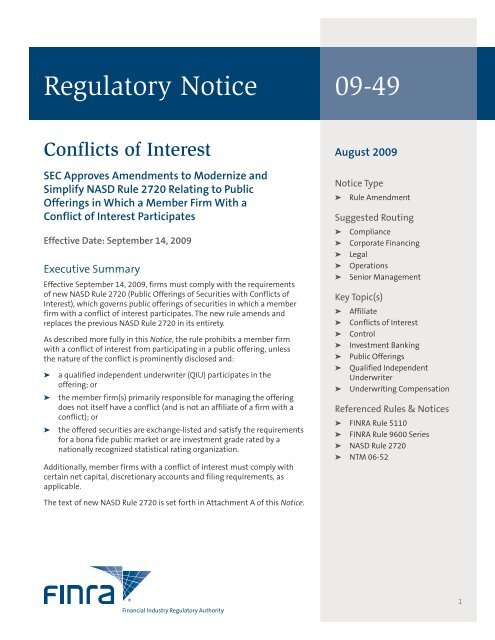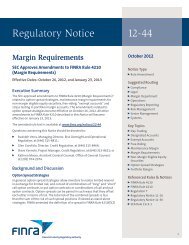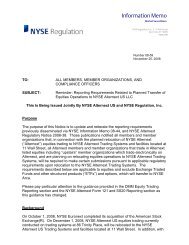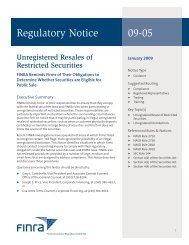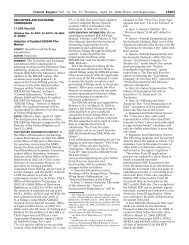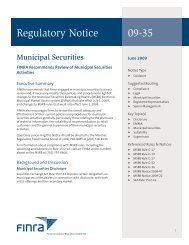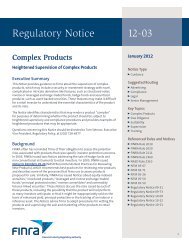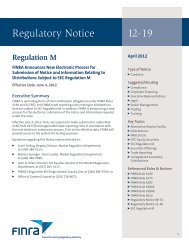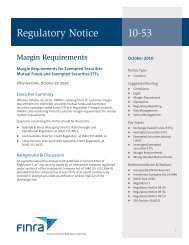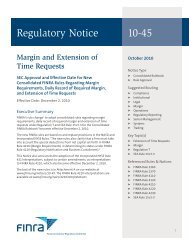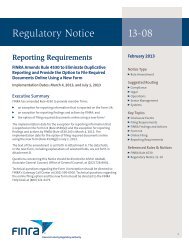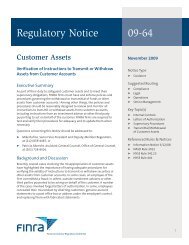Regulatory Notice 09-49 - finra
Regulatory Notice 09-49 - finra
Regulatory Notice 09-49 - finra
Create successful ePaper yourself
Turn your PDF publications into a flip-book with our unique Google optimized e-Paper software.
<strong>Regulatory</strong> <strong>Notice</strong> <strong>09</strong>-<strong>49</strong>Conflicts of InterestSEC Approves Amendments to Modernize andSimplify NASD Rule 2720 Relating to PublicOfferings in Which a Member Firm With aConflict of Interest ParticipatesEffective Date: September 14, 20<strong>09</strong>Executive SummaryEffective September 14, 20<strong>09</strong>, firms must comply with the requirementsof new NASD Rule 2720 (Public Offerings of Securities with Conflicts ofInterest), which governs public offerings of securities in which a memberfirm with a conflict of interest participates. The new rule amends andreplaces the previous NASD Rule 2720 in its entirety.As described more fully in this <strong>Notice</strong>, the rule prohibits a member firmwith a conflict of interest from participating in a public offering, unlessthe nature of the conflict is prominently disclosed and:➤➤➤a qualified independent underwriter (QIU) participates in theoffering; orthe member firm(s) primarily responsible for managing the offeringdoes not itself have a conflict (and is not an affiliate of a firm with aconflict); orthe offered securities are exchange-listed and satisfy the requirementsfor a bona fide public market or are investment grade rated by anationally recognized statistical rating organization.Additionally, member firms with a conflict of interest must comply withcertain net capital, discretionary accounts and filing requirements, asapplicable.August 20<strong>09</strong><strong>Notice</strong> Type➤Rule AmendmentSuggested Routing➤➤➤➤➤ComplianceCorporate FinancingLegalOperationsSenior ManagementKey Topic(s)➤➤➤➤➤➤➤AffiliateConflicts of InterestControlInvestment BankingPublic OfferingsQualified IndependentUnderwriterUnderwriting CompensationReferenced Rules & <strong>Notice</strong>s➤ FINRA Rule 5110➤ FINRA Rule 9600 Series➤ NASD Rule 2720➤ NTM 06-52The text of new NASD Rule 2720 is set forth in Attachment A of this <strong>Notice</strong>.1
<strong>09</strong>-<strong>49</strong>August 20<strong>09</strong>Questions regarding this <strong>Notice</strong> should be directed to:➤ Paul Mathews, Director, Corporate Financing Department, at (240) 386-4623;➤ Lisa Toms, Associate Director and Senior Counsel, Corporate Financing Department,at (240) 386-4661;➤ Gary Goldsholle, Vice President and Associate General Counsel, Office of GeneralCounsel (OGC), at (202) 728-8104; and➤ Lisa Horrigan, Associate General Counsel, OGC, at (202) 728-8190.Background & DiscussionNASD Rule 2720 governs public offerings of securities issued by participating memberfirms or their affiliates, public offerings in which a member or any of its associatedpersons or affiliates has a conflict of interest, and public offerings that result in aFINRA member becoming a public company.On June 15, 20<strong>09</strong>, the SEC approved amendments to Rule 2720 to modernize andsimplify the rule. 1 New Rule 2720 prohibits a member firm with a “conflict of interest”from participating in a public offering unless certain requirements are met. The newrule also significantly revises the definition of “conflict of interest,” as described inmore detail below.When a member firm with a conflict of interest participates in a public offering, thenew rule requires “prominent disclosure” in the prospectus, offering circular or similardocument of the nature of the conflict of interest and, where a QIU is required, thename of the member firm acting as the QIU and a brief statement regarding the roleand responsibilities of the QIU. 2 The prominent disclosure requirement applies to allofferings within the scope of new Rule 2720, whether or not a filing with FINRA isrequired. 3The new rule combines the previous rule’s tests of what constitutes an affiliate andconflict of interest into a single definition of “conflict of interest.” 4 As defined in Rule2720(f)(5), a conflict of interest exists, if at the time of a member firm’s participationin a public offering, any of the following four conditions applies:➤➤➤The securities are to be issued by the member firm.The issuer controls, is controlled by or is under common control with the memberfirm or the member firm’s associated persons. 5At least five percent of the net offering proceeds, not including underwritingcompensation, are intended to be: (i) used to reduce or retire the balance of aloan or credit facility extended by the member firm, its affiliates and its associatedpersons, in the aggregate; or (ii) otherwise directed to the member firm, itsaffiliates and associated persons, in the aggregate. 62 <strong>Regulatory</strong> <strong>Notice</strong>
August 20<strong>09</strong><strong>09</strong>-<strong>49</strong>➤If, as a result of the public offering and any transactions contemplated at thetime of the public offering: (i) the member firm will be an affiliate of the issuer;(ii) the member firm will become publicly owned; or (iii) the issuer will become amember firm or form a broker-dealer subsidiary.When a member firm with a conflict of interest participates in a public offering, a QIUmay be required. If so, the QIU must participate in the preparation of the registrationstatement and the prospectus, offering circular or similar document (i.e., the offeringdocument) and exercise the usual standards of due diligence with respect to theoffering document. The new rule eliminates the pricing responsibilities of the QIU.Any offering that requires a QIU must be filed with FINRA’s Corporate FinancingDepartment for review pursuant to FINRA Rule 5110 (Corporate Financing Rule). 7FINRA notes that while the term “participation in a public offering” in Rule 2720generally has the same meaning as in FINRA Rule 5110, 8 the new rule continues toapply specifically to a member firm’s participation in the distribution of a publicoffering as an underwriter, member of the underwriting syndicate or selling group,or otherwise assisting in the distribution of the public offering (i.e., not when amember firm acts solely as a finder, consultant or advisor, given these capacitiesgenerally do not involve managing or distributing a public offering).There are circumstances in which a member firm with a conflict of interest mayparticipate in a public offering without the use of a QIU. Specifically, the new ruleeliminates the need for a QIU if: (i) the member firm with a conflict of interest or anaffiliate is not managing the offering; or (ii) the offered securities have a “bona fidepublic market” or are “investment grade rated” or are securities in the same series thathave equal rights and obligations as investment grade rated securities (e.g., securitiesissued under a medium-term note program). FINRA notes that the definition of “bonafide public market” in Rule 2720(f)(3) is changed substantially from the definition of“bona fide independent market,” which it replaces, in that the new rule defines a bonafide public market in accordance with the numerical standards set forth in the SEC’sRegulation M under the Exchange Act. 9In cases where two or more book-running lead managers have equal responsibilitieswith regard to due diligence, each must be free of conflicts of interest, otherwise theQIU provisions under the new rule would apply and the offering would be subject tothe filing requirements under Rule 5110.If a QIU is not required, the offering will not have to be filed with FINRA. Whether ornot a filing is required, however, the new rule still requires prominent disclosure of thenature of the conflict in the offering documents. In addition, a member firm with aconflict of interest must comply with the discretionary accounts requirement, andwhere applicable the escrow, net capital computation and related disclosure provisionsof the rule, as described below.<strong>Regulatory</strong> <strong>Notice</strong> 3
<strong>09</strong>-<strong>49</strong>August 20<strong>09</strong>Public Offering of a Member Firm: Escrow and Net CapitalComputationWhen a member firm participates in a public offering of its own securities, the new rulerequires that all of the offering proceeds be placed in a duly established escrow accountand not be released or used by the member firm in any manner until the member firmhas complied with the net capital requirements set forth in the rule. 10 The new rulealso requires any member firm offering its securities to disclose in the registrationstatement, offering circular or similar document a date by which the offering isreasonably expected to be completed and the terms upon which the proceeds willbe released from the escrow account. These requirements are substantively similarto the provisions under previous Rule 2720.Discretionary AccountsThe new rule also requires a member firm that has a conflict of interest to comply witha prohibition on sales to discretionary accounts, unless the member firm has receivedspecific written approval of the transaction from the account holder and retainsdocumentation of the approval in its records. 11 These requirements only apply to themember firm with the conflict. FINRA notes, however, that they apply whether or notthe offering must be filed and whether or not the securities are investment grade ratedor have a bona fide public market. In addition, the “specific written approval”requirement can be satisfied by an email from the customer.DefinitionsNew Rule 2720 provides a set of definitions for purposes of the rule and incorporates,by reference, the definitions in FINRA Rule 5110. A number of definitions in the newrule are substantially similar to the definitions set forth in previous Rule 2720, whileother terms in new Rule 2720 are newly defined, including “control,” “entity,”“investment grade rated” and “prominent disclosure.”FINRA notes that the definition of “control” under Rule 2720(f)(6) includes beneficialownership of ten percent or more of the outstanding common equity (which is definedto expressly include non-voting stock), subordinated debt or preferred equity of an“entity,” which is defined in Rule 2720(f)(7). 12 FINRA also notes that the exclusions inthe term “entity” are substantially similar to the exemptions from the conflict ofinterest provisions contained in previous Rule 2720, with the exception of an entity thatissues financing instrument-backed securities, which is now subject to the rule.4 <strong>Regulatory</strong> <strong>Notice</strong>
August 20<strong>09</strong><strong>09</strong>-<strong>49</strong>“Control” includes not only shares beneficially owned by a participating memberfirm, but also the right to receive such securities within 60 days of the member firm’sparticipation in the public offering. As a result, the determination of control is basedon when the member firm participates in an offering, not the date that a registrationstatement for the offering is declared effective. For example, warrants or rights toacquire voting securities that are exercisable within 60 days of the member firm’sparticipation in the public offering would be included in the calculation of votingsecurities when determining whether control exists. The calculation to determinecontrol, however, is limited to securities that could be received by the participatingmember firm only and would not include securities underlying warrants or rights heldby other investors. 13FINRA also notes that the term “qualified independent underwriter” is defined in newRule 2720(f)(12). The definition retains the provisions that require Section 11 liabilityundertakings and eligibility requirements relating to experience in managing offerings.The new rule extends to ten years the disqualification provisions regarding thedisciplinary history of associated persons responsible for due diligence.The new rule prohibits QIUs from receiving more than five percent of the offeringproceeds. Receipt of such proceeds would disqualify a member firm from acting as aQIU because it would fall within the definition of “conflict of interest.” In addition, aQIU cannot beneficially own, as of the date of its participation in the public offering,more than five percent of the class of securities that would give rise to a conflict ofinterest, including any right to receive any such securities exercisable within 60 days.Member firms are reminded that FINRA permits firms to provide informationestablishing that they meet the QIU qualification requirements in advance ofparticipating in a particular public offering and that they may update this informationannually. In the course of its review of information in connection with a public offeringrequiring a QIU, FINRA staff routinely asks for information that establishes that amember firm identified as a QIU is qualified to participate in that capacity. If a memberfirm has already provided this information within the last 12 months or has done anannual update, it will generally not need to provide the information in connection withthat particular offering. In this regard, firms should consider updating the informationthat they previously provided in light of the changes to the QIU qualificationrequirements that are in the new rule.Requests for Exemption from NASD Rule 2720Paragraph (e) provides that, pursuant to the FINRA Rule 9600 Series, FINRA may inexceptional and unusual circumstances, taking into consideration all relevant factors,exempt a member firm unconditionally or on specified terms from any or all of theprovisions of Rule 2720 that it deems appropriate.<strong>Regulatory</strong> <strong>Notice</strong> 5
<strong>09</strong>-<strong>49</strong>August 20<strong>09</strong>Endnotes1 See Exchange Act Release No. 60113 (June 15,20<strong>09</strong>), 74 FR 29255 (June 19, 20<strong>09</strong>) (orderapproving SR-FINRA-2007-0<strong>09</strong>). See also <strong>Notice</strong>to Members (NTM) 06-52 (September 2006).The SEC also approved conforming changesto FINRA Rule 5110, including the transfer ofcertain definitions from Rule 2720 to FINRARule 5110.2 See Rule 2720(a)(2)(B) regarding QIU disclosurerequirements. “Prominent disclosure” isdefined in Rule 2720(f)(10) and may includethe notation “(Conflicts of Interest)” followingthe listing of the Plan of Distribution in theTable of Contents section and a disclosure inthe Plan of Distribution section and anyProspectus Summary section as required inSEC Regulation S-K. For offering documentsnot subject to SEC Regulation S-K, prominentdisclosure may be provided on the front pageof the offering document stating that aconflict exists, with a cross-reference to thediscussion within the offering document.These methods of disclosure are non-exclusive,and FINRA will consider alternative—butequally prominent—disclosures on a case-bycasebasis.3 With regard to a takedown from a shelfregistration statement that became effectiveprior to September 14, 20<strong>09</strong>, the disclosurerequirements in Rule 2720(a) could beincluded in, and would apply only to, apost effective amendment or prospectussupplement that is filed with the SEC on orafter September 14, 20<strong>09</strong>.4 A revised definition of “affiliate” under Rule2720(f)(1) means an entity that controls, iscontrolled by or is under common controlwith a member firm.5 The definition of “control” under Rule2720(f)(6) includes beneficial ownership of tenpercent or more of the outstanding commonequity, subordinated debt or preferred equityof an “entity,” which is defined in Rule2720(f)(7).6 FINRA notes that the five-percent thresholdapplies to each participating member firmindividually (including the member firm’saffiliates and its associated persons). Thus,for example, a conflict of interest would existwhere a member firm receives five percentof the offering proceeds, but not where twounaffiliated member firms each receive threepercent of the proceeds.7 See NASD Rule 2720(d). FINRA Rule 5110generally requires member firms to filewith FINRA public offerings for reviewof the proposed underwriting terms andarrangements and requires disclosure ofunderwriting compensation and that amember firm obtains a “no objections” opinionprior to participating in the offering. FINRARule 5110(b)(7) contains certain exemptionsfrom the filing requirements for, amongothers, public offerings of the securities ofseasoned issuers and offerings of investmentgrade debt, but such offerings must be filedif subject to the filing requirement underRule 2720.8 See FINRA Rule 5110(a)(5).© 20<strong>09</strong> FINRA. All rights reserved. FINRA and other trademarks of the Financial Industry <strong>Regulatory</strong> Authority,Inc. may not be used without permission. <strong>Regulatory</strong> <strong>Notice</strong>s attempt to present information to readers in aformat that is easily understandable. However, please be aware that, in case of any misunderstanding, therule language prevails.6 <strong>Regulatory</strong> <strong>Notice</strong>
August 20<strong>09</strong><strong>09</strong>-<strong>49</strong>Endnotes continued9 Specifically, “bona fide public market” isdefined as a market for a security issued by acompany that has been reporting under theExchange Act for at least 90 days, is current inits reporting requirements and whosesecurities are traded on a national securitiesexchange with an average daily tradingvolume of at least $1 million, provided that theissuer’s common equity securities have apublic float value of at least $150 million.10 The rule also requires any member firmoffering its securities to immediately notifyFINRA when the public offering has beenterminated and file with FINRA a computationof its net capital computed pursuant to theprovisions of SEC Rule 15c3-1 (the net capitalrule) as of the settlement date. Member firmsare also reminded that additional escrowaccount maintenance and paymentrequirements may be applicable under SECRule 15c2-4 for “best efforts” offerings.12 For purposes of the rule, the percentage ofcontrol may be calculated using a “flowthrough” concept by looking throughownership levels to calculate the totalpercentage of control.13 FINRA clarified in Amendment No. 1 to its rulefiling (SR-FINRA-2007-0<strong>09</strong>) that in calculatingthe percentage of beneficial ownership, it isappropriate to include the securities to bereceived by the participating member firm inboth the numerator and denominator, butthat this calculation should not includesecurities that could be received by all otherinvestors. See Exchange Act Release No. 60113(June 15, 20<strong>09</strong>), 74 FR 29255 (June 19, 20<strong>09</strong>)(order approving SR-FINRA-2007-0<strong>09</strong>).11 This prohibition is independent of anyprovisions in NASD Rule 2510.<strong>Regulatory</strong> <strong>Notice</strong> 7
<strong>09</strong>-<strong>49</strong>August 20<strong>09</strong>ATTACHMENT ABelow is the text of the amendments. New language is underlined; deletions are in brackets.* * * * *5000. SECURITIES OFFERING AND TRADING STANDARDS AND PRACTICES5100. SECURITIES OFFERINGS, UNDERWRITING AND COMPENSATION5110. Corporate Financing Rule – Underwriting Terms andArrangements(a) DefinitionsFor purposes of this Rule, the following terms shall have the meanings statedbelow. The definitions in NASD Rule 2720 are incorporated herein by reference.(1) through (10) No Change.(11) CompanyA corporation, a partnership, an association, a joint stock company, a trust, afund, or any organized group of persons whether incorporated or not; or anyreceiver, trustee in bankruptcy or similar official or any liquidating agent for any ofthe foregoing, in his capacity as such.(12) Effective DateThe date on which an issue of securities first becomes legally eligible fordistribution to the public.(13) Immediate FamilyThe parents, mother-in-law, father-in-law, spouse, brother or sister, brother-inlawor sister-in-law, son-in-law or daughter-in-law, and children of an employee orassociated person of a member, except any person other than the spouse andchildren who does not live in the same household as, have a business relationshipwith, provide material support to, or receive material support from, the employeeor associated person of a member. In addition, the immediate family includes anyother person who either lives in the same household as, provides material supportto, or receives material support from, an employee or associated person of amember.8 <strong>Regulatory</strong> <strong>Notice</strong>
August 20<strong>09</strong><strong>09</strong>-<strong>49</strong>(14) PersonAny natural person, partnership, corporation, association, or other legal entity.(b) Filing Requirements(1) through (6) No Change.(7) Offerings Exempt from FilingNotwithstanding the provisions of subparagraph (1) above, documents andinformation related to the following public offerings need not be filed with FINRAfor review, unless subject to the provisions of NASD Rule 2720(a)(2). However, itshall be deemed a violation of this Rule or NASD Rule 2810, for a member toparticipate in any way in such public offerings if the underwriting or otherarrangements in connection with the offering are not in compliance with thisRule or NASD Rule 2810, as applicable:(A) through (G) No Change.(8) through (9) No Change.(c) through (g) No Change.[(h) Proceeds Directed to a Member][(1) Compliance With NASD Rule 2720][No member shall participate in a public offering of an issuer’s securitieswhere more than 10% of the net offering proceeds, not including underwritingcompensation, are intended to be paid to participating members, unless the priceat which an equity issue or the yield at which a debt issue is to be distributed tothe public is established pursuant to NASD Rule 2720(c)(3).][(2) Disclosure][All offerings included within the scope of paragraph (h)(1) shall disclose in theunderwriting or plan of distribution section of the registration statement, offeringcircular or other similar document that the offering is being made pursuant to theprovisions of this subparagraph and, where applicable, the name of the memberacting as qualified independent underwriter, and that such member is assumingthe responsibilities of acting as a qualified independent underwriter in pricing theoffering and conducting due diligence.]<strong>Regulatory</strong> <strong>Notice</strong> 9
<strong>09</strong>-<strong>49</strong>August 20<strong>09</strong>[(3) Exception From Compliance][The provisions of paragraphs (h)(1) and (2) shall not apply to:][(A) an offering otherwise subject to the provisions of NASD Rule 2720;][(B) an offering of securities exempt from registration with the SEC underSection 3(a)(4) of the Securities Act;][(C) an offering of a real estate investment trust as defined in Section 856of the Internal Revenue Code; or][(D) an offering of securities subject to NASD Rule 2810, unless the netoffering proceeds are intended to be paid to the above persons for the purposeof repaying loans, advances or other types of financing utilized to acquire aninterest in a pre-existing company.](i) through (j) redesignated as (h) through (i).* * * * *NASD Rule 2720 is replaced in its entirety by the following new rule language.2720. Public Offerings of Securities With Conflicts of Interest(a) Requirements for Participation in Certain Public OfferingsNo member that has a conflict of interest may participate in a public offeringunless the offering complies with subparagraphs (1) or (2).(1) There must be prominent disclosure of the nature of the conflict of interestin the prospectus, offering circular or similar document for the public offering, andone of the following conditions must be met:(A) the member(s) primarily responsible for managing the public offeringdoes not have a conflict of interest, is not an affiliate of any member that doeshave a conflict of interest, and meets the requirement of paragraph (f)(12)(E);(B) the securities offered have a bona fide public market; or(C) the securities offered are investment grade rated or are securities in thesame series that have equal rights and obligations as investment grade ratedsecurities.10 <strong>Regulatory</strong> <strong>Notice</strong>
August 20<strong>09</strong> <strong>09</strong>-<strong>49</strong>(2) (A) A qualified independent underwriter has participated in thepreparation of the registration statement and the prospectus, offering circular,or similar document and has exercised the usual standards of “due diligence”in respect thereto; and(B) there must be prominent disclosure in the prospectus, offering circularor similar document for the offering of:(i) the nature of the conflict of interest;(ii) the name of the member acting as qualified independentunderwriter; and(iii) a brief statement regarding the role and responsibilities of thequalified independent underwriter.(b) Escrow of Proceeds; Net Capital Computation(1) All proceeds from a public offering by a member of its securities shall beplaced in a duly established escrow account and shall not be released therefromor used by the member in any manner until the member has complied withsubparagraph (2) hereof.(2) Any member offering its securities pursuant to this Rule shall immediatelynotify FINRA when the public offering has been terminated and settlementeffected and shall file with FINRA a computation of its net capital computedpursuant to the provisions of SEC Rule 15c3-1 under the Act (the net capital rule) asof the settlement date. If at such time its net capital ratio as so computed is morethan 10:1 or, net capital fails to equal 120 percent of the minimum dollar amountrequired by Rule 15c3-1 or, in the event the member calculates its net capitalrequirement using the alternative standard (set forth in Rule 15c3-1(a)(1)(ii)), itsnet capital is less than seven percent of aggregate debit items as computed inaccordance with Rule 15c3-3a, all monies received from sales of securities of thepublic offering must be returned in full to the purchasers thereof and the offeringwithdrawn, unless the member has obtained from the Commission a specificexemption from the net capital rule. Proceeds from the sales of securities in thepublic offering may be taken into consideration in computing net capital ratio forpurposes of this paragraph.<strong>Regulatory</strong> <strong>Notice</strong> 11
<strong>09</strong>-<strong>49</strong>August 20<strong>09</strong>(3) Any member offering its securities pursuant to this Rule shall disclose inthe registration statement, offering circular or similar document a date by whichthe offering is reasonably expected to be completed and the terms upon which theproceeds will be released from the escrow account described in paragraph (b)(1).(c) Discretionary AccountsNotwithstanding Rule 2510, no member that has a conflict of interest may sell to adiscretionary account any security with respect to which the conflict exists, unless themember has received specific written approval of the transaction from the accountholder and retains documentation of the approval in its records.(d) Application of Rule 5110Any public offering subject to paragraph (a)(2) is subject to Rule 5110, whether ornot the offering would be otherwise exempted from the filing or other requirements ofthat rule.(e) Requests for Exemption from Rule 2720Pursuant to the Rule 9600 Series, FINRA may in exceptional and unusualcircumstances, taking into consideration all relevant factors, exempt a memberunconditionally or on specified terms from any or all of the provisions of this rule that itdeems appropriate.(f) DefinitionsThe definitions in Rule 5110 are incorporated herein by reference. For purposes ofthis Rule, the following words shall have the stated meanings:(1) AffiliateThe term “affiliate” means an entity that controls, is controlled by or is undercommon control with a member.(2) Beneficial OwnershipThe term “beneficial ownership” means the right to the economic benefits of asecurity.12 <strong>Regulatory</strong> <strong>Notice</strong>
August 20<strong>09</strong> <strong>09</strong>-<strong>49</strong>(3) Bona Fide Public MarketThe term “bona fide public market” means a market for a security of an issuerthat has been reporting under the Act for at least 90 days and is current in itsreporting requirements, and whose securities are traded on a national securitiesexchange with an Average Daily Trading Volume (as provided by Regulation Munder the Act) of at least $1 million, provided that the issuer’s common equitysecurities have a public float value of at least $150 million.(4) Common EquityThe term “common equity” means the total number of shares of common stockoutstanding without regard to class, whether voting or non-voting, convertible ornon-convertible, exchangeable or non-exchangeable, redeemable or nonredeemable,as reflected on the consolidated financial statements of the company.(5) Conflict of InterestThe term “conflict of interest” means, if at the time of a member’s participationin an entity’s public offering, any of the following applies:(A) the securities are to be issued by the member;(B) the issuer controls, is controlled by or is under common control withthe member or the member’s associated persons;(C) at least five percent of the net offering proceeds, not includingunderwriting compensation, are intended to be:(i) used to reduce or retire the balance of a loan or credit facilityextended by the member, its affiliates and its associated persons, in theaggregate; or(ii) otherwise directed to the member, its affiliates and associatedpersons, in the aggregate; or(D) as a result of the public offering and any transactions contemplated atthe time of the public offering:(i) the member will be an affiliate of the issuer;(ii) the member will become publicly owned; or(iii) the issuer will become a member or form a broker-dealersubsidiary.<strong>Regulatory</strong> <strong>Notice</strong> 13
<strong>09</strong>-<strong>49</strong>August 20<strong>09</strong>(6) Control(A) The term “control” means:(i) beneficial ownership of 10 percent or more of the outstandingcommon equity of an entity, including any right to receive such securitieswithin 60 days of the member’s participation in the public offering;(ii) the right to 10 percent or more of the distributable profits or lossesof an entity that is a partnership, including any right to receive an interestin such distributable profits or losses within 60 days of the member’sparticipation in the public offering;(iii) beneficial ownership of 10 percent or more of the outstandingsubordinated debt of an entity, including any right to receive suchsubordinated debt within 60 days of the member’s participation in thepublic offering;(iv) beneficial ownership of 10 percent or more of the outstandingpreferred equity of an entity, including any right to receive such preferredequity within 60 days of the member’s participation in the public offering;or(v) the power to direct or cause the direction of the management orpolicies of an entity.(B) The term “common control” means the same natural person or entitycontrols two or more entities.(7) EntityFor purposes of the definitions of affiliate, conflict of interest and control underthis Rule, the term “entity”:(A) includes a company, corporation, partnership, trust, sole proprietorship,association or organized group of persons; and(B) excludes the following:(i) an investment company registered under the Investment CompanyAct of 1940;(ii) a “separate account” as defined in Section 2(a)(37) of theInvestment Company Act of 1940;14 <strong>Regulatory</strong> <strong>Notice</strong>
August 20<strong>09</strong> <strong>09</strong>-<strong>49</strong>(iii) a “real estate investment trust” as defined in Section 856 of theInternal Revenue Code; or(iv) a “direct participation program” as defined in Rule 2810.(8) Investment Grade RatedThe term “investment grade rated” refers to securities that are rated by anationally recognized statistical rating organization in one of its four highestgeneric rating categories.(9) Preferred EquityThe term “preferred equity” means the aggregate capital invested by allpersons in the preferred securities outstanding without regard to class, whethervoting or non-voting, convertible or non-convertible, exchangeable or nonexchangeable,redeemable or non-redeemable, as reflected on the consolidatedfinancial statements of the company.(10) Prominent DisclosureA member may make “prominent disclosure” for purposes of paragraphs (a)(1)and (a)(2)(B) by:(A) providing the notation “(Conflicts of Interest)” following the listing ofthe Plan of Distribution in the Table of Contents section required in Item 502 ofSEC Regulation S-K, and by providing such disclosures in the Plan ofDistribution section required in Item 508 and any Prospectus Summary sectionrequired in Item 503 of SEC Regulation S-K; or(B) for an offering document not subject to SEC Regulation S-K, byproviding disclosure on the front page of the offering document that a conflictexists, with a cross-reference to the discussion within the offering documentand in the summary of the offering document if one is included.(11) Public OfferingThe term “public offering” means any primary or secondary offering ofsecurities made pursuant to a registration statement or offering circular includingexchange offers, rights offerings, offerings made pursuant to a merger oracquisition and all other securities offerings of any kind whatsoever, except anyoffering made pursuant to:<strong>Regulatory</strong> <strong>Notice</strong> 15
<strong>09</strong>-<strong>49</strong>August 20<strong>09</strong>(A) an exemption from registration under Sections 4(1), 4(2), or 4(6) of theSecurities Act of 1933;(B) SEC Rule 504, if the securities are “restricted securities” under SEC Rule144(a)(3), SEC Rules 505 or 506; or(C) SEC Rule 144A or Regulation S.The term public offering shall exclude exempted securities as defined inSection 3(a)(12) of the Act.(12) Qualified Independent UnderwriterThe term “qualified independent underwriter” means a member:(A) that does not have a conflict of interest and is not an affiliate of anymember that has a conflict of interest;(B) that does not beneficially own as of the date of the member’sparticipation in the public offering, more than 5% of the class of securities thatwould give rise to a conflict of interest, including any right to receive any suchsecurities exercisable within 60 days;(C) that has agreed in acting as a qualified independent underwriter toundertake the legal responsibilities and liabilities of an underwriter under theSecurities Act of 1933, specifically including those inherent in Section 11thereof; and(D) that has served as underwriter in at least three public offerings of asimilar size and type during the three-year period immediately preceding thefiling of the registration statement or the date of first sale in an offeringwithout a registration statement. This requirement will be deemed satisfied if,during the past three years, the member:(i) with respect to a proposed public offering of debt securities, hasacted as sole underwriter or book-running lead or co-manager of at leastthree public offerings of debt securities each with gross proceeds of notless than 25% of the anticipated gross proceeds of the proposed offering;and(ii) with respect to a proposed public offering of equity securities, hasacted as sole underwriter or book-running lead or co-manager of at leastthree public offerings of equity securities (or of securities convertible intoequity securities), each with gross proceeds of not less than 50% of theanticipated gross proceeds of the proposed offering.16 <strong>Regulatory</strong> <strong>Notice</strong>
August 20<strong>09</strong> <strong>09</strong>-<strong>49</strong>(E) none of whose associated persons in a supervisory capacity who areresponsible for organizing, structuring or performing due diligence withrespect to corporate public offerings of securities:(i) has been convicted within ten years prior to the filing of theregistration statement or the preparation of an offering circular in anoffering without a registration statement of a violation of the anti-fraudprovisions of the federal or state securities laws, or any rules or regulationspromulgated thereunder, in connection with a registered or unregisteredoffering of securities;(ii) is subject to any order, judgment, or decree of any court ofcompetent jurisdiction entered within ten years prior to the filing of theregistration statement, or the preparation of an offering circular in anoffering without a registration statement, permanently enjoining orrestraining such person from engaging in or continuing any conduct orpractice in violation of the anti-fraud provisions of the federal or statesecurities laws, or any rules or regulations promulgated thereunder inconnection with a registered or unregistered offering of securities; or(iii) has been suspended or barred from association with any memberby an order or decision of the Commission, any state, FINRA or any otherself-regulatory organization within ten years prior to the filing of theregistration statement, or the preparation of an offering circular in anoffering without a registration statement, for any conduct or practice inviolation of the anti-fraud provisions of the federal or state securities laws,or any rules, or regulations promulgated thereunder, or the anti-fraud rulesof any self-regulatory organization in connection with a registered orunregistered offering of securities.(13) Registration StatementThe term “registration statement” means a registration statement as definedby Section 2(a)(8) of the Securities Act of 1933; notification on Form 1A filed withthe Commission pursuant to the provisions of SEC Rule 252 under the SecuritiesAct of 1933; or any other document, by whatever name known, initiating aregistration or similar process for an issue of securities which is required to be filedby the laws or regulations of any federal or state agency.<strong>Regulatory</strong> <strong>Notice</strong> 17
<strong>09</strong>-<strong>49</strong>August 20<strong>09</strong>(14) Subordinated DebtThe term “subordinated debt” includes (A) debt of an issuer which is expresslysubordinate in right of payment to, or with a claim on assets subordinate to, anyexisting or future debt of such issuer; or (B) all debt that is specified assubordinated at the time of issuance. Subordinated debt shall not include shorttermdebt with maturity at issuance of less than one year and secured debt andbank debt not specified as subordinated debt at the time of issuance.* * * * *18 <strong>Regulatory</strong> <strong>Notice</strong>


